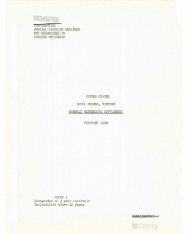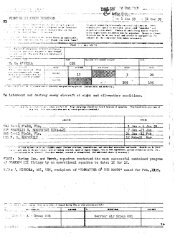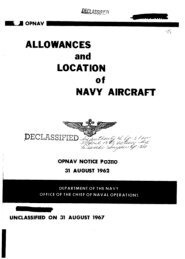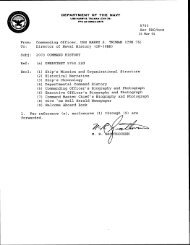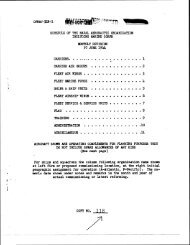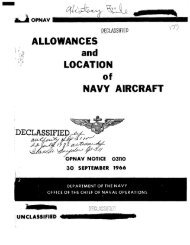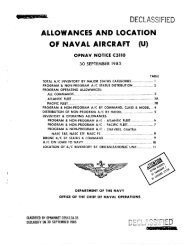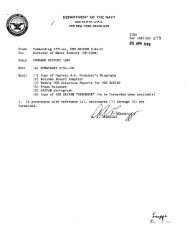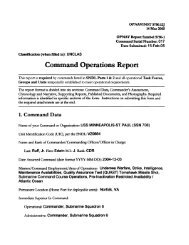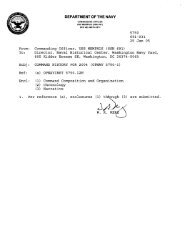VP-9 - Naval History and Heritage Command - U.S. Navy
VP-9 - Naval History and Heritage Command - U.S. Navy
VP-9 - Naval History and Heritage Command - U.S. Navy
You also want an ePaper? Increase the reach of your titles
YUMPU automatically turns print PDFs into web optimized ePapers that Google loves.
98 DICTIONARY OF AMERICAN NAVAL AVIATION SQUADRONS—Volume 2<br />
bow, red, yellow, green <strong>and</strong> blue; lightning bolts,<br />
white; surface ship, gray; submarine, black; sea, bluegreen;<br />
border of design, blue; letters of squadron at<br />
bottom, white on background of light blue.<br />
The fifth <strong>and</strong> final insignia of the squadron was a<br />
return to the third, more historic version originally approved<br />
after the squadron became <strong>VP</strong>-17 in 1953. The<br />
A squadron P4Y-2 (PB4Y-2) in flight.<br />
The squadron’s fifth insignia<br />
reverted back to<br />
the third insignia design.<br />
design <strong>and</strong> colors remained essentially unchanged<br />
from the earlier version. The request for the reversion<br />
to the earlier design was approved by CNO on 26<br />
March 1993.<br />
Nickname: White Lightnings, 1959–1995.<br />
Chronology of Significant Events<br />
May 1946: <strong>VP</strong>-916 was established at NAS Los<br />
Alamitos, Calif. The squadron came under the operational<br />
control of FAW-4 <strong>and</strong> administrative control by<br />
<strong>Naval</strong> Air Reserve Training (NARTU). It was another of<br />
the 21 naval reserve squadrons established after the<br />
war to accommodate the large number of aircrews recently<br />
released from active duty <strong>and</strong> utilize the enormous<br />
stocks of aircraft on the inventory. The squadron<br />
flew the Lockheed PV-2 Harpoon <strong>and</strong> the amphibious<br />
Consolidated PBY-5A Catalina.<br />
15 Nov 1946: All patrol squadrons were redesignated.<br />
Regular <strong>Navy</strong> patrol squadron designation numbers<br />
began with 1 <strong>and</strong> reserve squadron numbers<br />
began with 5. <strong>VP</strong>-916 was redesignated <strong>VP</strong>-ML-66. The<br />
ML designation, medium patrol squadrons, included<br />
twin-engine medium amphibious seaplanes, as well as<br />
twin-engine l<strong>and</strong>-based bombers. Regular <strong>Navy</strong> patrol<br />
squadrons with the ML designation were for twin-engine<br />
medium l<strong>and</strong>-based bombers only. The amphibious<br />
medium seaplanes like the PBY-5A used the AM,<br />
amphibian designation for regular <strong>Navy</strong> squadrons.<br />
Feb 1950: <strong>VP</strong>-ML-66 was redesignated <strong>VP</strong>-772 during<br />
the reorganization of <strong>Naval</strong> Aviation reserve units<br />
in 1949, but the change did not take effect until<br />
February 1950. During this period the number of<br />
<strong>Naval</strong> Aviation reserve squadrons was reduced from<br />
the 1949 total of 24 to 9.<br />
1 Sep 1950: <strong>VP</strong>-772 was called to active duty by the<br />
president for service during the Korean War. The<br />
squadron relocated from its home base at Los<br />
Alamitos, Calif., to NAS Whidbey Isl<strong>and</strong>, Wash.<br />
Aircrews were given transition training for conversion<br />
to the Consolidated P4Y-2/2S (a redesignated PB4Y-2)<br />
Privateer. The 2S version of this aircraft featured surface<br />
search radar. A brief lull occurred in the intensive<br />
training cycle when the squadron paid a visit to the<br />
fighting French in Saigon. The squadron left several<br />
Privateers for use by the French in the Indochina war.<br />
1–31 Jan 1951: <strong>VP</strong>-772 deployed to Iwakuni, Japan,<br />
where <strong>VP</strong>-772 became the first activated naval reserve<br />
squadron to participate in the Korean conflict. On 31<br />
January 1951, the squadron began combat operations<br />
from NAS Atsugi, Japan, flying missions over Korea,<br />
the Sea of Japan, the Yellow Sea <strong>and</strong> the Tsushima<br />
Straits.<br />
Jun–Aug 1951: From 12 June through the end of<br />
August several of the squadron’s aircraft were detached<br />
in two-aircraft elements for operations with the<br />
night attack aircraft of the 1st Marine Air Wing at K-1<br />
Pusan, South Korea. The detachment provided direct<br />
support for ground operations by dropping MK-6<br />
flares at night to provide illumination for USMC<br />
ground attack aircraft. Although initially an experiment,<br />
the operations proved so successful they were<br />
continued by other similarly equipped patrol<br />
squadrons.<br />
1 Jan–Feb 1953: <strong>VP</strong>-772 deployed to NAS Barbers<br />
Point, Hawaii, in preparation for duty in the Korean<br />
combat zone. On 1 February 1953, the squadron<br />
began combat operations from Iwakuni, Japan, flying<br />
missions over the Sea of Japan, Tsushima Straits <strong>and</strong><br />
the Yellow Sea. The squadron was the last to fly the<br />
P4Y-2/2S in combat. No losses in personnel or equipment<br />
were incurred in 435 combat missions.<br />
4 Feb 1953: <strong>VP</strong>-772 was augmented into the regular<br />
<strong>Navy</strong> <strong>and</strong> redesignated <strong>VP</strong>-17. Toward the end of the<br />
Korean War the decision was made to augment all of<br />
the nine reserve patrol squadrons activated during the<br />
1950 to 1951 time period as part of the regular <strong>Navy</strong>.<br />
The redesignations did not require changes in tail<br />
codes or home bases.



